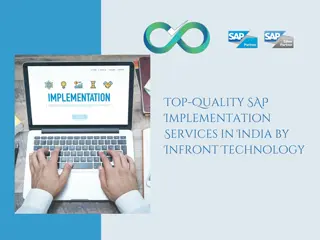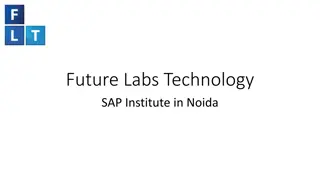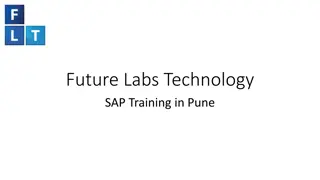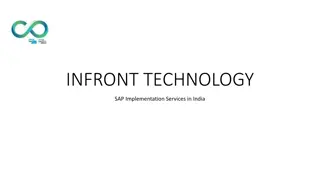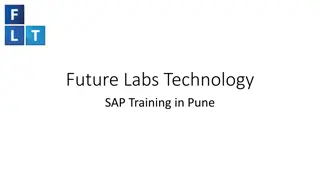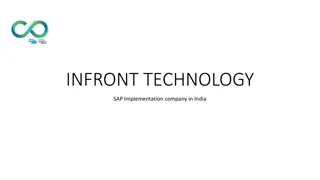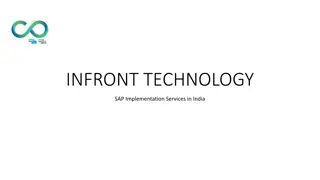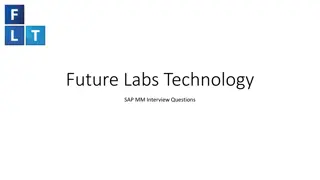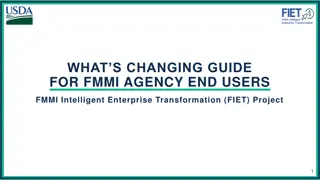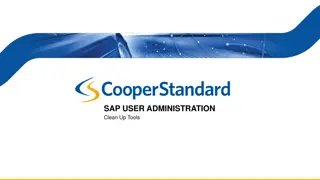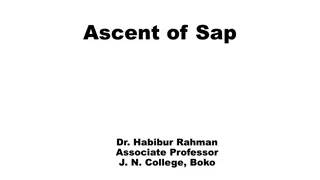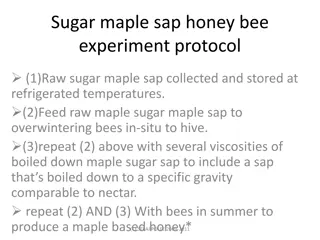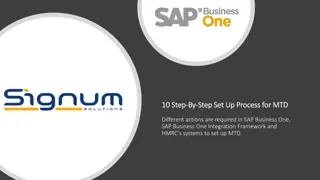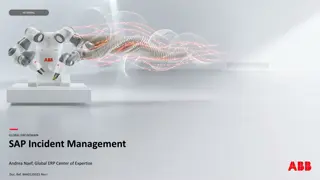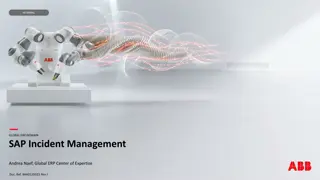Understanding FIET Project: Objectives, Relation to SAP, and More
FIET (FMMI Intelligent Enterprise Transformation) is a project to migrate the existing FMMI system from SAP ECC to SAP S/4HANA, aiming to enhance efficiency through process optimization, data management, and improved user experience. It involves transitioning to modern technologies like Fiori and integrating systems for streamlined operations. Explore the objectives and key aspects of FIET to understand its impact on USDA's financial management.
Download Presentation

Please find below an Image/Link to download the presentation.
The content on the website is provided AS IS for your information and personal use only. It may not be sold, licensed, or shared on other websites without obtaining consent from the author. Download presentation by click this link. If you encounter any issues during the download, it is possible that the publisher has removed the file from their server.
E N D
Presentation Transcript
FIET FREQUENTLY ASKED QUESTIONS 1. What is FIET? 2. How are SAP, FMMI, FIET, Portal, and Fiori related to each other? 3. What are the objectives of FIET? 4. What is the project timeline? 5. What is my role as a stakeholder? 6. How will customers be involved? 7. What is a code blackout vs. a code brownout? 8. What are the key changes end users will see in the new system? 9. Will FIET impact agency-level security? 10.Will support be available to end users to prepare them for the change? 11.Does USDA have a training plan? 12.What will the conversion process be? 13.Will there be fit gap analysis performed with processes and interfaces? 14.Will impacts to agency-specific interfaces be identified and reconciled? 15.What is a Change Champion and a Super User? 16.What are the next steps? 17.Where can I ask additional questions?
WHAT IS FIET? FIET (FMMI Intelligent Enterprise Transformation) is the project in which we are migrating the existing FMMI system from SAP ECC to SAP S/4HANA. This project represents a key milestone in our organization's journey towards digital transformation and enhanced efficiency. FMMI SAP S/4HANA version FMMI SAP ECC version FIET Project Current financial system Future financial system #1
HOW ARE SAP, FMMI, FIET, PORTAL, AND FIORI RELATED TO EACH OTHER? SAP is a company that provides the SAP software platform. FMMI(Financial Management Modernization Initiative) isUSDA s department-wide instance of SAP. FMMI will be upgraded via the FIET (FMMI Intelligent Enterprise Transformation) Project in February 2025. User Interfaces (UIs)are front doors that FMMI users can use to access the system. Portal is USDA s browser- based GUI that most FMMI users use to access the system. SAP GUI is an interface used by a small set of FMMI users in FMS. Fiori is a modern, app-based interface that FMMI users will use to access the system. Scenario 1: Portal will continue to exist when FMMI is upgraded, but only for a subset of users. Scenario 2: Portal will continue to exist when FMMI is upgraded, but only for a subset of transactions. Scenario 1: Fiori will be used for a subset of users for all transactions. Scenario 2: Fiori will be used for the 100 most common FMMI transactions. #2
WHAT ARE THE OBJECTIVES OF FIET? Our FIET Project objectives are to streamline processes, optimize operations, and provide a foundation for future growth. Transitioning from SAP ECC to S/4HANA will allow us to manage business functions in real time and enhance the following areas: SYSTEM MODERNIZATION Transform SAP Enterprise Resource Planning (ERP) Central Component (ECC) to S/4HANA through a Selective Data Transition. PROCESS OPTIMIZATION Review and refine our existing business processes to align with best practices and industry standards. DATA MANAGEMENT Enhance data quality, integrity, and accessibility through improved data governance practices. USER EXPERIENCE Enhance user experience through Fiori User Experience (UX) - the new version of the FMMI Portal. INTEGRATION Establish integration between existing Customer Relationship Management (CRM) Grantor and S/4HANA. VALUE DELIVERY Deliver cost-effective and scalable financial solutions for OCFO to provide best value services. #3
WHAT IS THE PROJECT TIMELINE? Over the next year, we will follow a structured timeline: 1 Planning and Preparation Detailed project planning, resource allocation, and technical assessments. 2 System Migration Migration of our systems to S/4HANA, including data migration and system configuration. 3 Testing and Validation Rigorous testing to ensure the new system meets our business requirements and standards. 4 Targeted FMMI upgrade go- live date is February 17, 2025 Deployment Rollout of S/4HANA, including training and support for end-users. 5 Optimization & Continuous Improvement Post-deployment activities to fine-tune the system and monitor performance. #4
WHAT IS MY ROLE AS A STAKEHOLDER? Your role as a stakeholder is to provide feedback, which will help us make informed decisions and address any challenges that may arise. The success of this project is dependent on user engagement and support. We encourage open communication, feedback, and collaboration throughout this transition. #5
HOW WILL CUSTOMERS BE INVOLVED? System Integration Testing 2 (SIT 2) Aug. Sept. 2024 Production Readiness Testing Oct. 2024 Jan. 2025 End User Training Nov. 2024 Feb. 2025 Deployment Cutover & Go Live Feb. 2025 Hypercare Post Go Live Support 90 Days Post Go-Live Agency Super Users will be asked to test all interfaces end-to-end to ensure they are working as planned. Agency business users will conduct end-to-end validation testing. Agency users will be trained on the new Fiori user interface and any minor application function changes. Agencyparticipation in post go-live validation as required. Our vendor partners will closely monitor the customer service, data integrity, and smooth operation of the implemented S/4HANA solution. Agency interaction may be required to troubleshoot agency-specific issues. #6 *Dates are tentative and will be updated as needed as the project progresses.
WHAT IS A CODE BROWNOUT VS. A CODE BLAKOUT? A brownout is a period where fewercode changes are made than usual, allowing work to wind down before a blackout. FMMI Code Brownout period is September 2023 May 31, 2024 FMS will make only minor system enhancements (<100 Hours) A blackout is period where no code changes or modifications are allowed. FMMI Code Blackout will take place June 1, 2024 January 2025 FMS will make emergency system changes only. No other system changes will be planned or implemented. #7
WHAT ARE THE KEY CHANGES END USERS WILL SEE IN THE NEW SYSTEM? The most notable changes to FMMI can be grouped into three categories: 3 2 1 Customer-Vendor Integration Fiori Simplified Data Model Combining data tables into a single Universal Journal improves performance and data accuracy Customer and Vendor data will all now be tracked as Business Partner data to simplify data structures Introducing a fresh, new user interface with a modern, mobile-friendly look and feel For more information on each of these changes, please refer to the FIET Introduction document. #8
WILL FIET IMPACT AGENCY-LEVEL SECURITY? No, there will be no impact on security administration processes. #9
WILL SUPPORT BE AVAILABLE TO END USERS TO PREPARE THEM FOR THE CHANGE? Yes, support will be available throughout this transition to make the process as smooth as possible. There are three main ways we will help our end users navigate this change: COMMUNICATIONS We will share regular, iterative updates in O&M calls, emailed bulletins, and on our web page to ensure that end users receive frequent updates on project progress, upcoming change impacts, and more. TRAINING SYSTEM INTEGRATION TESTING INVOLVEMENT We are engaging the Super Users in testing the system to ensure it is working as expected and as needed to complete business processes. We will be designing training for end users that will ensure they are prepared to do their jobs in the upgraded system at go-live. Our goal is to over-communicate rather than under-communicate, to ensure that all end users are familiar with the FIET Project, are not caught by surprise, and are able to do their jobs in the upgraded system. #10
DOES USDA HAVE A TRAINING PLAN? Yes, we will identify who needs to be trained, what they need to be trained on, and how and when they will be trained. Perform Learning Needs Assessment Design Learning Curriculum and Plan Create a Learning Strategy Develop the Learning Materials Deliver and Deploy Learning Evaluate the Learning Program Deliver Train-the- Trainer sessions to USDA trainers to prepare them to deliver training to end users. Schedule training just-in-time, shortly before go- live, to ensure that learning is fresh in users minds before go-live. Evaluate the learning program to determine its effectiveness and identify any areas for improvement. Gather feedback from the workforce, assess the adoption rates of the new S/4HANA technologies, and/or measure the impact of the learning program on business outcomes. Identify learning challenges, opportunities, and vision to develop an effective S/4HANA learning strategy. Identify the major areas of upcoming change where end users will most benefit from training support. Develop EnableNow simulations and Quick Reference Guides to support end user just-in-time learning models. Perform Learning Needs Analysis for insights, analyzing learning needs for end users as a result of S/4HANA deployment and ensuring that the learning program addresses the specific needs of the learners and improves user adoption. Design a Learning Curriculum and Plan that aligns with project goals and meets learners' needs. Map business roles to ensure learning materials are aligned with their role in the system. #11
WHAT WILL THE CONVERSION PROCESS BE? FMS will use a Selective Data Transition, which migrates only relevant data to the new system. This type of conversion is better than a more traditional System Conversion because it avoids migrating outdated information. Bring business processes to the new platform A complete technical in-place conversion of an existing SAP ECC system, like FMMI, to SAP S/4HANA Moves everything, the good and the bad, to the new system System Conversion SAP SAP ECC System S/4HANA FMS Approach Partly re-use, partly re-implement Covers the migration of relevant business data from SAP ECC to SAP S/4HANA Allows business process redesign while retaining historical data Selective Data Transition SAP ECC System(s) SAP S/4HANA #12
WILL THERE BE FIT GAP ANALYSIS PERFORMED WITH PROCESSES AND INTERFACES? Yes, the FIET functional team has already begun a fit gap analysis. Super Users will actively participate in working sessions with the FIET functional team to determine impact on business processes. Impact on agency interfaces will be minimal and addressed in multiple rounds of testing. Results from the analysis will also factor into the training plan. Fits SAP S/4HANA best practices and standard processes Agency business processes Gaps #13
WILL IMPACTS TO AGENCY-SPECIFIC INTERFACES BE IDENTIFIED AND RECONCILED? FMS is working to prevent any changes to agency interfaces. FMMI-side changes to interfaces are being identified and are minimal. Multiple rounds of testing will ensure the integrity of FMMI interfaces to other systems. FMS will test all corporate interfaces and direct entry documents in SIT 1 and SIT 2. Test Phase Summary Agency Resources Targeted Timeframe Testing all interface changes to ensure they continue working as planned System Integration Testing 1 (SIT 1) None May July 2024 Testing all interfaces end-to- end to ensure they are working as planned Super Users (previously identified) System Integration Testing 2 (SIT 2) August September 2024 Agency business users (to be identified) Production Readiness Testing (PRT) End-to-end validation testing October 2024 January 2025 #14
WHAT IS A CHANGE CHAMPION AND A SUPER USER? Change Champions and Super Users are agency representatives who provide support to the FIET Project by: Change Champion Super User Communicating key FIET Project updates to their agency YES Collecting questions and feedback from end users to share with the FIET Project team YES Gauging the effectiveness of FIET communications YES Advising on how processes are used by agencies YES Ensuring processes align with business needs YES Participating in functional workshops, data validation, system integration testing, etc. YES #15
WHAT ARE THE NEXT STEPS? You will receive communication from FMS at every stage of the transition process via emailed bulletins. You will also be notified of opportunities to learn more about FIET as training becomes available. Make sure you are subscribed to email updates! Subscribe here. #16
WHERE CAN I ASK ADDITIONAL QUESTIONS? Please reach out to the following resources with any FIET-related questions or concerns: Help Desk Agency CAM #17





